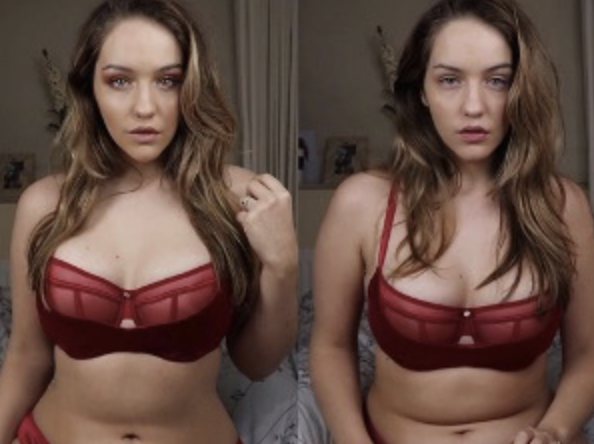
Foucault’s vision on the morphing bodies of influencers
Among the most controversial topics of the 21st century lies the term ‘body modification’. A term coined centuries ago when people altered their body to take part in a particular culture or tradition. The concept transcended over the years to the point where the line between what is real and fake has become blurred. With the aid of editing apps such as Facetune or Photoshop, it is very much embedded in our contemporary culture that those with significant influence contort themselves to suit the norms of society’s current ‘aesthetic’ using merely the tip of their fingers. Using theoretical notions from the French philosopher Michel Foucault we will attempt to dissect the reasons why people have this immense urge to change and display the presentation of their bodies on varying platforms. Our article will revolve around two influencers namely Monica Gueze and Joann van den Herik, who actively reveal how much editing is involved in photos and videos on social media.
Foucault's Perspective
We can apply Foucault's theories to digital media today. For example, we can gather that social media involves subjectivation, the process by which one analyzes, interprets, and recognizes themself and others as a domain of possible knowledge: “[t]he way the subject experiences [her]self in a game of truth where [s]he relates to [her]self” (Foucault, 1998). Influencers online are conscious and careful with what they share, as they are aware that they are being exposed to a form of virtual panopticon. The panopticon, social media in this case, is based on the concept of Jeremy Bentham. He created a prison in which a central observation tower had a full 360 degrees vision on the prison and the cells; every prisoner could constantly be held under surveillance. Knowing this, all the prisoners behaved like they were constantly held under supervision. Foucault called this sense of constant governance ‘discipline blockade’ (Foucault & Sheridan, 2020). This selective performance extends the panopticon metaphor that can be seen in his book ‘Abnormal’, where he sketches the metaphor as a village in quarantine (Foucault, 2003).

Figure 1. Screenshot on Instagram @Monica Geuze
Filters and Photoshop
Editing images has become a standard part of social media culture, we know this as countless influencers have begun to reveal or speak about the reality behind filters and photoshop. Monica Gueze and Joann van den Herik are two influencers who are great examples of the consequences of of media on people with significant influence.
Influencers often edit and morph their bodies to live up to the social norm
The Dutch influencer and YouTuber Monica Geuze, for example, recently posted these two pictures, see Figure 1, on her Instagram to give her followers insight into how she and other influencers often edit and morph their bodies to live up to the social norm. Geuze has been well-known for showing both sides of the influencer lifestyle since she started vlogging her day-to-day life on YouTube in 2015. She often films herself without make-up and filters to give her followers a legitimate impression of what her life is like; we know this as a filter would not be able to follow her face entirely when she is facing to the side. While it may seem as though Geuze often displays her natural self, she admits to feeling like she needs to edit them to abide by the virtual panopticon. People are inclined to subscribe to the social pact as closely as possible because too much diversion from the social norm is seen as abnormal. An abnormal person is a threat to society, and many people want to avoid this negative label. In Geuze’s new book ‘Unreleased’, she describes her struggles with social media and how the version the public gets to see isn’t always as unedited as they might think. She explains how her life as an influencer is marked by a strategic authenticity in which she tends to show the best possible version of herself while still trying to appear genuine and trustworthy.
What Monica Geuze chooses to share often has to do with what is considered socially acceptable. Sharing a snippet of realness won’t do any harm. In this screenshot from her YouTube vlog from 2016, she shows a rare video of herself without make-up to appear natural and genuine to her followers. If she were to deviate from the norm entirely, she would, in essence, be exposing her raw self and move towards the abnormal, which would likely result in an abundance of negative hate comments. The micro-penalties that arise from this, which Foucault discusses (they are a form of punishment for deviant behavior), almost serve as retribution to remind one to stick to the idealistic portrayal of an influencer. Through likes and positive comments, influencers like Monica Geuze do not merely receive affirmation that they are worth following but get this reinforced feeling that they are producing content in line with the norm.
"He who is subjected to a field of visibility, and who knows it, assumes responsibility for the constraints of power…...he becomes the principle of his own subjection." (Foucault, 1998)
In this context, influencers and social media users feel pressured into behaving a certain way to ensure they maintain their status, therefore
people ought to alter their bodies to not appear ‘too different' from society. But why would somebody then want to unveil their body morphing to the general public? This almost seems contradictory in that influencers like Monica Geuze depict perfection on the surface, and then reveal in snippets that all of that perfection is fake. A reason for this could be that people have come to realize that the discipline blockade is stressful and creates misery. Viewers and social media users have been made aware of the ease of alteration and thus crave authenticity in those they follow. At the same time though, this no-filter trend has failed to rid of the panoptic nature of social media. People are still using it as a means of seeking validation and still receive constant backlash for whatever content it is they produce.
To break out of this social panopticon, our society must broaden its social norms by slowly normalizing what deviates from the masses or by encouraging individuals to simply accept that there will always be eccentricity. Ultimately, we must reach a point where all of mankind can freely act without fear of diverting from the social pact that previously would have made them a threat to society. This role of breaking the silence can only logically be granted to social media influencers. They are the ever-present face of our social media and thus hold immense power to change the norm created by conformism. And as the name ‘influencers’ inclines, the influence they have over many people will only extend their reach in the transformation of these norms.
Seeking protection through exposing flaws
Another reason could have to do with Moralized Behavior Scripts (MBS); ‘imaginable situations in marked (i.e. nonrandom) spacetime, provoking enregistered (and therefore normative, expected and presupposed) modes of behavior.’ (Blommaert, 2015). A moralized behavioral script essentially refers to being able to presume one's behavior prior to an occurrence based on the situation and how this may provoke the person.
Influencers are constantly held under a looking glass by, for example, paparazzi and Instagram accounts such as @celebface and @beautyfalse. So, by ‘exposing’ themselves, doing something that opposes their presuspected behavior, influencers sideline people who could potentially expose them to a much deeper extent. In doing so, they limit the negative side effects that one would normally receive. In other words, it is more valuable to show your flaws to society yourself than to be pointed at your flaws by society.

To further analyze our theory we will move onto the second case study, Joann van den Herik, to see whether influencers tend to create a superficial image of themselves. Joann van den Herik is a Dutch influencer who has built her brand surrounding the body positivity movement. A movement striving towards the acceptance of all bodies and aiming at combatting societal perceptions of size and appearance. Joann thrives off of her ‘delving’ away from the norm and is well-known for encouraging women that do not fit the social standards to be proud of their bodies. Among all of this, she has however revealed that her so-called unfiltered images have been altered by means of posing to fit the standards of the patriarchy. In Figure 2, van den Herik has indirectly exposed that what she posts online is a mere highlight reel of her life, like every other user on social media. She shows herself on the left side of the picture, wearing make-up and sitting up straight to conceal her body rolls. So, ultimately we discover that we only know a minuscule part of who she really is. We have been tricked into believing that because she falls within a subcategory of body-positive people that the content she exhibits to the public is unfiltered and raw. We can conclude from this that even those who stand for body positivity don’t always present an honest picture of their bodies, and can use this as a reminder of just how fake the internet can be. Van Den Herik is a perfect example that indicates that the social pact is powerful; even somebody with a large following by advocating for body positivity feels the need to alter her body to a certain degree and display a different version of herself.
Foucault stresses the importance of this idea of a 'readable body', particularly how we read them to the most microscopic detail. We see how discursive forces on social media read and consequently shape influencers like Monica Geuze and Joann van den Herik. The way influencers possess a kind of strategic authenticity online applies to the Foucaultian notion that the way we organize our body reflects our ultimate control over it. Their power and control are stripped from them when the raw exposure of themself lands in the wrong hands and gets amplified. It is thus of utter importance that they stry close to the norm to maintain control on it.
Even though Michel Foucault’s theory originates from a time without social media, his findings of the panopticon society and its social norms are still highly relevant in the online era. By observing the online content of two Dutch influencers, Monica Geuze and Joann van den Herik, we discovered that living up to the social norm and the fear of being abnormal has led to a strategic authentic appearance of online personas. It has become the norm to slightly edit your body to correspond with the current aesthetic ideal while still maintaining an authentic image so they in essence are presenting a specific version of the truth. Social media has helped reinforce Foucault’s metaphor of the panopticon due to the constant awareness of followers, likes, and comments, mimicking the observation tower in the original theory. As a result of this perpetual sense of being watched, every act on social media is performative, and people tend to show themselves at their best when all eyes are pointed to them. Even the influencers who advocate the opposite, like Joann van den Herik, morph and edit their bodies to avoid the risk of falling out and becoming abnormal, whether it’s by photoshopping their flaws or by adjusting the position in which they portray themselves. In the end, nobody is perfect, but we’re all striving for excellence because that has become the social norm nowadays.
References
Foucault, M., 1998, Aesthetics, Method, And Epistemology (Essential Works Of Foucault, 1954-1984, Vol 2), New Press.
Foucault, M., (2003). Abnormal: lectures at the College de France, 1974-1975. Verso.
Foucault, M., & Sheridan, A. (2020). Discipline and punish: the birth of the prison. Penguin Books.
Blommaert, J. (2015). Language, behavioral scripts, and valuation: Comments on “Transnationalizing Chineseness” .
